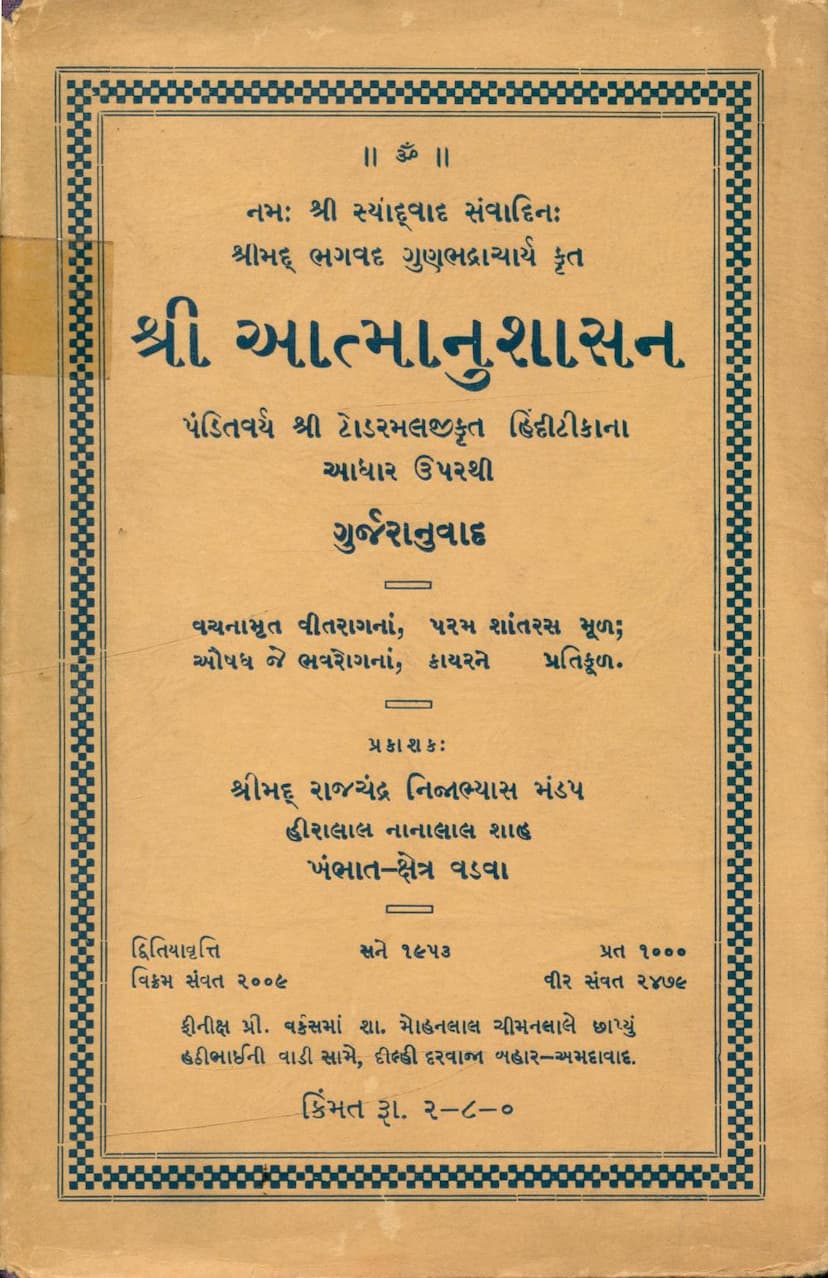Atmanushasan
Added to library: September 1, 2025

Summary
Here is a comprehensive summary of the Jain text "Atmanushasan" by Somchand Amthalal Shah, based on the provided pages:
Book Title: Atmanushasan (Meaning "Self-Discipline" or "Guidance for the Soul")
Author: Somchand Amthalal Shah
Publisher: Shrimad Rajchandra Nijabhyas Mandap
Original Work: Attributed to Shri Gunabhadracharya (as indicated by the introductory verses). The translation and commentary are based on the Hindi commentary by Pandit Todarmalji.
Nature of the Text: "Atmanushasan" is presented as a profound spiritual text containing the "nectar of the enlightened ones" (Vachanāmrut Vītarāgnanām), offering the essence of ultimate peace and acting as medicine for the disease of worldly existence, though it may be difficult for the faint-hearted.
Author's Intent and Journey (as described in the Preface): The translator, Somchand Amthalal Shah, expresses his motivation for undertaking the Gujarati translation. He found the original Sanskrit text to be deeply beneficial for his own soul and, inspired by a sense of devotion towards it, began the commentary. He acknowledges the challenging nature of the vast subject matter and his own intellectual limitations, quoting from the Bhaktāmara Stotra to convey that his devotion, rather than his scholarship, compelled him to undertake this work. He also mentions receiving encouragement and consent from his elder well-wisher, making the translation a fruition of collective effort and divine grace.
Key Themes and Content:
The text is a commentary and translation of "Atmanushasan," originally authored by Shri Gunabhadracharya. The summary covers a wide range of Jain philosophical and ethical principles, presented through the commentary and explanatory verses. The core themes revolve around:
-
The Nature of the Soul and Liberation: The text emphasizes that the true essence of the soul is pure consciousness and bliss, which is obscured by karmas. The ultimate goal is liberation (Moksha), which is achieved through right faith (Samyak Darshan), right knowledge (Samyak Gyan), and right conduct (Samyak Charitra), along with austerities (Tapas).
-
The Importance of Right Knowledge and Conduct:
- Right Faith (Samyak Darshan): This is the foundational step, involving correct understanding of the seven tattvas (realities) and the eradication of the twenty-five faults (doshas) like delusion, doubt, and misapprehensions. It is described as the first step on the path to liberation.
- Right Knowledge (Samyak Gyan): The text stresses the importance of understanding the true nature of reality, distinguishing between the soul (Atman) and non-soul (pudgala). Knowledge is depicted as the means to overcome ignorance and delusion.
- Right Conduct (Samyak Charitra): This involves adhering to vows and ethical principles, with a focus on non-violence (Ahimsa), truthfulness, non-stealing, celibacy, and non-possession. The text details various levels of conduct, from minor vows (Anuvrat) to major vows (Mahavrat) for ascetics.
-
The Path of Asceticism (Muni Dharma): The text extols the virtues and practices of ascetics, who renounce worldly possessions and attachments to pursue spiritual liberation. It highlights their detachment, self-control, and pursuit of knowledge and contemplation as the means to overcome karmic bondage.
-
The Nature of Suffering and Attachment: The text repeatedly emphasizes that worldly existence is inherently filled with suffering (Dukkha). This suffering arises from attachment (Raga) and aversion (Dvesha) to worldly objects and experiences, which are all impermanent.
-
The Role of Austerities (Tapas): Austerities are presented as a crucial means to purify the soul and weaken the grip of karmas. Various forms of internal and external austerities are implicitly discussed as essential for spiritual progress.
-
Critique of Worldly Pursuits: The text strongly advises against attachment to worldly pleasures, wealth, relationships, and even the body itself, viewing them as impermanent and ultimately sources of suffering. The pursuit of mere worldly happiness is likened to seeking oil in sand or trying to increase life by drinking poison.
-
The Nature of the Soul: The soul is described as eternal, pure, conscious, and inherently blissful, but its true nature is obscured by ignorance and karmas. The goal of spiritual practice is to realize this inherent nature.
-
The Importance of Detachment and Renunciation: True happiness is found in detachment from worldly pleasures and possessions. The text advocates for renunciation of all attachments as the path to liberation.
-
The Ideal Teacher and Listener: The text also outlines the qualities of an ideal spiritual teacher (Guru) and a receptive disciple (Shishya), emphasizing wisdom, detachment, compassion, clarity of speech for the teacher, and eagerness, humility, and thoughtfulness for the listener.
-
The Illusion of Material Happiness: The text persistently argues that material possessions, worldly status, and sensual pleasures are fleeting and ultimately lead to suffering. They are likened to mirages or transient states that cannot provide lasting peace.
-
The Five Perfections (Gunas): The text implicitly refers to the five supreme perfections of the soul (Kshama, Mardava, Arjava, Saucha, Satya, etc.) as the ultimate goal and means of attainment.
Commentary and Translation Approach: The Gujarati translation aims to clarify the profound meaning of the original Sanskrit text, drawing heavily on Pandit Todarmalji's Hindi commentary. The translator's humility and devotion are evident throughout.
Overall Message: "Atmanushasan" serves as a guide for spiritual discipline and self-realization. It encourages a life of ethical conduct, detachment, self-control, and contemplation of the soul's true nature. The text underscores the impermanence of worldly life and the illusory nature of sensual pleasures, urging the reader to turn inwards and seek the eternal bliss of the soul, which is the ultimate liberation.